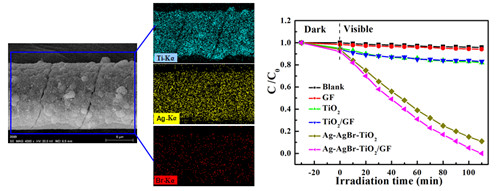Researchers Prepared Fibre-based Photocatalyst with Micro/nano-scale TiO2 on Glass Fibres
Editor: | Jul 03,2015
Photocatalysis based on semiconductors is regarded as a promising technology to solve the problems associated with the air and water pollution. Among numerous semiconductors, titanium dioxide (TiO2) has obvious advantages over other semiconductors due to its low cost, non-toxic, and stable performance. However, like other nanomaterials, TiO2 nanoparticles tend to aggregate in suspension, leading to a rapid loss in active sites and photocatalytic capability. In addition, the low efficiency on separating electron-hole pairs in the material limits the practice of TiO2 for wide photocatalytic applications.
To overcome these problems, the Nanocomposites team led by Prof. MA Pengcheng in Xinjiang Technical Institute of Physics and Chemistry of Chinese Academy of Sciences developed fibre-based photocatalyst with micro/nano-scale TiO2 on glass fibres. The material showed a higher efficiency for the degradation of pollutants than that of bulk TiO2 and excellent recyclability due to the increased specific surface area and the improved interfacial interactions between the photocatalyst and organic impurity in water. The result was published in Dalton Transactions.
Based on the previous work, the team extended the research to prepare fibre-based plasmonic photocatalyst consisting of nano-scale Ag-AgBr, sub-micro TiO2 and micro-scale glass fibre (GF), aiming at enhancing the photocatalytic capability of TiO2 using visible light and stabilizing this property under the cyclic runs. Researchers found that Ag-AgBr nanoparticles were highly dispersed on the surface of spherical TiO2/GF. The photocatalytic activities of photocatalyst were measured by the degradation of methyl orange (MO) under the visible light (λ ≥ 420 nm). The rate constant for MO degradation was 0.024 min-1, much higher than noble-metal doped TiO2 (0.0037-0.018 min-1) and commercial P-25 (0.0028-0.015 min-1, UV light). The removal ratio for MO remained > 85% even after five cycles. This enhancement was attributed to the synergistic effects arising from the hetero-junctions in the sample as well as the surface plasmon resonance of Ag nanoparticles. The result was published in Applied Catalysis B: Environmental.
The work was supported by the Western Light Program of CAS, Thousand Talent Program, etc.
The team recently got the support from the China-Germany Joint Research Project (PPP) sponsored by the Chinese Scholarship Council (CSC) and Deutsche Akademische Austausch Dienst (DAAD). Some members of the team will carry out joint research in Leibniz Institute of Polymer Research in Germany for the scale-up production of fiber-based photocatalyst.

Figure : Morphology of fibre-based plasmonic photocatalyst and photocatalytic capability under the visible light.(Image by XTIPC)
Contact:
Prof.MA Pengcheng
E-mail:mapc@ms.xjb.ac.cn
Xinjiang Technical Institute of Physics & Chemistry,CAS
附件下载:
 (86) 991-3838931
(86) 991-3838931 lhskj@ms.xjb.ac.cn
lhskj@ms.xjb.ac.cn (86)991-3838957
(86)991-3838957 40-1 Beijing Road
Urumqi, XinjiangChina
40-1 Beijing Road
Urumqi, XinjiangChina